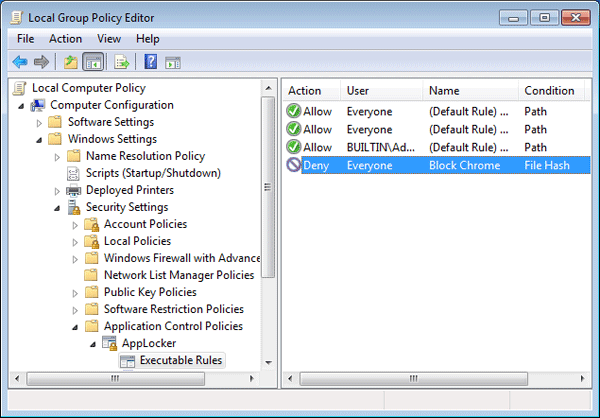
- #APPLOCKER POLICIES HOW TO#
- #APPLOCKER POLICIES INSTALL#
- #APPLOCKER POLICIES SOFTWARE#
- #APPLOCKER POLICIES WINDOWS 7#
In the Add or Remove Snap-ins dialog, click OK.In the Services dialog, keep the default setting of Local Computer and click Finish.In the Add or Remove Snap-ins dialog, select Services in the list of available snap-ins, and click Add.In the Select Group Policy Object window, keep the default setting of Local Computer and click Finish.In the Add or Remove Snap-ins dialog, select Group Policy in the list of available snap-ins, and click Add.In the MMC console window, press CTRL+M to add a new snap-in.Enter administrative credentials if prompted. In the search results pane on the right, right click the MMC icon and select Run as administrator from the menu.Click the Start button and on the Start screen type mmc.
#APPLOCKER POLICIES HOW TO#
Alternatively, you can configure a Group Policy Object for your domain following the instructions in “ How to Create and Link a Group Policy Object in Active Directory” on Petri. Let’s start by configuring a management console. In this article, I’ll show you how to set up AppLocker in Local Computer policy in Windows Server 2012 R2, but you could easily apply the same settings to multiple computers using Active Directory Group Policy.Ĭonfigure an MMC console (Image Credit: Russell Smith)
#APPLOCKER POLICIES SOFTWARE#
Configure AppLockerĪppLocker is much easier to set up than Software Restriction Policies (SRP), which is the Windows XP technology that AppLocker replaces. That’s where AppLocker comes in, by preventing users from running installer packages or scripts that haven’t been identified as trusted by IT.
#APPLOCKER POLICIES INSTALL#
Removing administrative privileges from users goes a long way in protecting devices from unwanted configuration change and malware, but alone doesn’t provide protection against scripts and portable software that might install itself into the user’s profile. AppLocker is only available in Enterprise and Ultimate editions of Windows.
#APPLOCKER POLICIES WINDOWS 7#
And not even a good one, at that – “AppBlocker” would have been more accurate! (If, admittedly, a little harder to pronounce.In today’s Ask the Admin, I’ll show you how best to set up application control policies in Windows using AppLocker.ĪppLocker was introduced in Windows 7 and can be used to prevent users from running executables, scripts, Windows Installer packages, and Windows Store apps (Windows 8 and higher) in Windows 7, Windows Server 2008 R2 and later. Maybe there are cool aspects of AppLocker that will become clearer as time progresses, but as far as I can see right now, it’s little more than a feature name change. That may or may not be a problem, depending on what type of software you’re trying to block. For example, one might create a rule that says “go ahead and let people run recent versions of COOLAPP, which are OK, but not older versions, which we know are buggy.” If the application’s digital signature doesn’t contain version information, however, it seems that this capability won’t work.


AppLocker appears to be a bit more sophisticated in that it can detect application versions, as long as they are present in the application’s digital signature. One of the new capabilities touted for Windows 7 clients is something called “AppLocker,” which purports to do pretty much the same thing as Software Restriction Policies. You can get more sophisticated and create rules such as “nobody’s allowed to run VBS scripts, but we’ll make an exception for GOODSCRIPT.VBS.” Because SRP’s are implemented via Group Policy, you can tailor them to different Organizational Units, sites, and domains. These are rules that basically say things like “nobody’s allowed to run AnnoyingProgramSetup.exe”. One of the cooler things that you can do with Group Policy in an Active Directory environment is set Software Restriction Policies, or SRP’s.


 0 kommentar(er)
0 kommentar(er)
